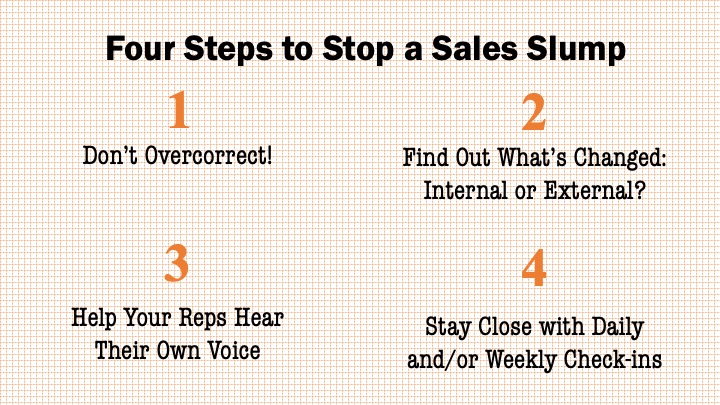One of the most frustrating sales management experiences happens when a rep who’s at the top of her game suddenly nosedives. A high performer who’s usually 150% of plan (or more) is now only producing 40% of plan (or less).
As I write this article, it’s the middle of the year and many sales leaders are coming to the stark realization that the team member they counted on in past years to help them hit their number is missing in action this year. And that realization has caused more than one sleepless night.
When a sales superstar slips into a slump, like any superstar, they won’t come out of it on their own. They need a leader who knows them well and who’s committed to coaching them back to the top of the leaderboard. And that leader must be you.
The actions you take at this crossroads will determine whether this person returns to superstar status or continues to crash and burn, ultimately leaving your team and the company, a completely unnecessary turnover.
Here are four critical steps to help a struggling salesperson recover from a slump:
- Don’t overcorrect
- Find out what’s changed
- Help them hear their own voice
- Stay close
Step 1: Don’t Overcorrect
The overwhelming temptation you face when a sales superstar slips into a slump is calling them into your office and ordering them to get with the program. Your frustration gets the best of you, and you give this person a metaphorical kick in the ass.
Guess what? This never works.
Just like driving your car on a dark road late at night and hitting a patch if ice, your first impulse is to pull the steering wheel hard to the right. But you know that if you do, your car will spin out of control and crash into the ditch.
The same is true in sales leadership. Overcorrection spins things out of control. Use a calm and steady hand to guide a salesperson through this challenge. Less is more here.
Ask lots of questions. Not questions that are veiled accusations, but open-ended questions that start with the words, “Help me understand …”
Now listen to the answers to your questions. Really listen. Double and triple click on your questions with words like, “How so? Tell me more …” Take the time to truly understand what’s going on and do all of this in private to protect the pride of a valuable star player.
Step 2: Find Out What’s Changed
As you control your impulse to overcorrect when a sales superstar slips into a slump and ask neutral, open-ended questions, you’ll begin to find out what’s changed. There are two possibilities: a change in the external environment or a change in the internal environment.
Imagine an aggressive competitor entering your marketplace and warm sales leads that came like clockwork from your web site drying up completely. As a result, your sales team has to generate their own sales leads through cold call prospecting against the backdrop of that aggressive competitor.
Notice how these two sales activities are totally different, converting warm leads from a web site and generating business through cold call prospecting. If this superstar who’s in a slump hasn’t done much—or any—cold call prospecting, the slump is due to a change in the external sales environment.
Your leadership response is coaching and training this salesperson, and perhaps the entire team, on the principles and practices of effective prospecting, so they can begin to thrive in this brave new world.
If, however, the sales activities needed to succeed in the marketplace have not changed, then there’s been a change in their internal environment. The degree of difficulty for you as a leader just went up exponentially. Training a salesperson on mastering a new sales activity is much easier than climbing into a salesperson’s heart and soul and reigniting a fire that’s gone out.
But climb in you must. Step 3 gives you the matches to use when you do.

Step 3: Help Them Hear Their Own Voice
When a sales superstar slips into a slump due to a change in their internal environment, that is, a dangerous drop in enthusiasm and motivation, your goal is to help them hear their own voice. For when a salesperson hears their own voice, they become self aware and begin to self correct. They find their own way out of the slump with you as their guide.
This happens, however, not through the dissemination of more information but through lighting the fire of inspiration. Again, overcorrection uses enforcement to address a sales slump, more calls, more meetings, more deals. The more button won’t work with a change in the internal environment, however, because that’s not the problem.
The problem is this salesperson’s why button not their more button. The problem is engagement not enforcement, and all the enforcement in the world won’t produce greater engagement. It’s like saying, “The beatings will stop when morale improves!” Well … how’s that going to happen?
Ask these questions to reignite the fire of engagement:
- What’s your motivation for selling? Family? Fortune? Fame? What gets you up in the morning ready to take on the day? How can you bring more of that motive to your work?
- What’s a big dream you have for your life? How will succeeding in sales this year get you closer to achieving this big dream for your life?
- What’s your long range goal professionally? How will succeeding in sales this year get you closer to achieving this professional goal?
- What’s something fun you want to do this year? A fun concert? A fun toy? A fun trip? How can succeeding in sales this year allow to do that activity?
Notice how all these questions seek to uncover a deeper why for work. We are wired for why as humans beings. When we have real, meaningful reasons for doing the things we do, we can achieve any how at any time. Even recovering from a sales slump.
MORE: Why Start with Why and the Power of the People Pyramid
Step 4: Stay Close
I grew up on 7th Avenue in Westwood, New Jersey. At the end of 7th Avenue was a big Catholic church that stood atop a steep hill. A buddy and I once drug our go-cart to this Catholic church and the top of that hill and began riding down.
Within a few feet, the right front wheel of our go-cart started to wobble. It got worse and worse until the go-cart was shaking uncontrollably. Sensing imminent danger, both of us jumped off, tearing our jeans to pieces and cutting up our knees and elbows.
To our horror, however, the go-cart kept going down the hill, smashing into to the side of a car parked at the bottom. Being red-blooded, 10-year-old boys, we ran for our lives.
In this hare-brained story is the secret to success with as sales superstar who’s slipped into a slump. Stay close to him or her.
You may have just come to the realization that this salesperson is struggling as you progress down the hill of your sales year, now halfway into it and beginning to see the wobbly wheel. Don’t act like my childhood friend and I did—and most sales leaders do—ignoring the wobbly wheel, hoping that it’ll fix itself.
It won’t and neither will your struggling superstar.
Stop the go-cart and fix the wheel immediately. Do this before downward momentum becomes irreversible and you crash at the bottom. Then, when a fix has been made, ride on the go-cart with this salesperson for awhile to make sure it sticks.
What this means in non-metaphorical terms is weekly one-on-one’s and daily check-ins until the slump is over. These meetings, however, are not disciplinary beat downs but developmental discussions. You’re not a cop catching someone doing something wrong, but a coach, co-creating a plan for returning this rep to top sales shape and holding them accountable for following that plan completely.
The reward you’ll get from a slumping salesperson for being this kind of leader goes way, way beyond recovered revenue from hitting their number again. You’ll also receive the reward of a lifetime of loyalty. And that’s the best gift any leader can receive.


